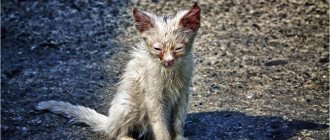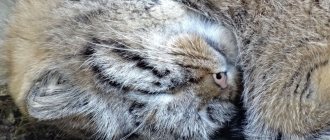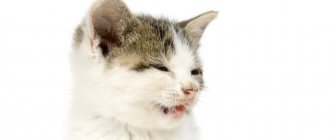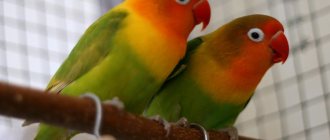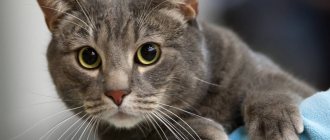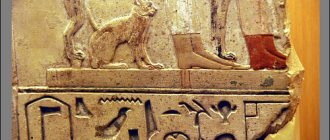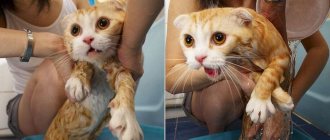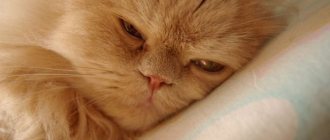Description and origin of the species
The first scientific description of the animal was given by the German naturalist Peter Simon Pallas in 1776. He met the animal while traveling in eastern Siberia, and gave the cat its first scientific name Felis manul.
In 1842, Johann-Friedrich von Brandt, a German naturalist working in Russia, proposed placing the animal in a separate genus of Pallas' cat (
Otocolobus
).
Later in 1907, the British zoologist Reginald Innes Poukok finally approved the classification: the animal is the only representative of the monotypic genus of Pallas's cats, and bears the scientific name Otocolobus manul.
The name manul is borrowed from the Kyrgyz language, and translated means “cat” in Kyrgyz. In Mongolian the word sounds a little different, “manol”. The name Pallas' cat was first proposed by the English zoologist William Blanford. Latin genus name Otocolobus
comes from ancient Greek, and literally means dwarf ear.
The closest relative of the animal is the genus Eastern cats (Prionailurus). It includes small predators of the cat family that live exclusively in Asia - the Bengal cat, the Sumatran cat, the fishing cat and the spotted cat. According to mitochondrial DNA analysis, the ancestors of Pallas's cat separated from a common ancestor with eastern cats from 9.4 to 1.46 million years ago.
Life in the wild
Pallas' cats are cats that lead a sedentary lifestyle; only extreme circumstances can force the animal to leave its hole. Each manul has its own territory, where it will observe with displeasure the presence of other representatives of its own breed.
The cat lives in cozy dens, which are crevices, shelters under stones, and small caves. The Pallas's cat will also happily settle in abandoned burrows of other animals.
With the help of a hole, the animal protects itself from the sweltering summer heat and winter cold. As massive and stern as the manul looks, it is an absolutely non-conflict animal that prefers not to get involved in fights with other representatives of the wild.
The diet is quite varied - the Pallas's cat hunts small birds, eats insects, and small rodents. In addition, the fluffy cat's menu includes gophers, rabbits, and marmots. The Pallas's cat hunts in the following way: it finds the prey, hides, keeps watch, waiting for an opportune moment to attack, and as soon as it is confident in its abilities, and the prey loses its vigilance, it attacks.
The manul prefers to hunt passively, luring its prey for a long time and capturing it with one throw.
The animal is unable to run for long distances - this is due to the modest size of the heart muscle, which is not designed for such loads.
Enemies
In the wild, the Pallas cat is of no interest to other animals. The only representative of the fauna that the Pallas's cat is afraid of are wolves. The cat is also afraid of large birds of prey - eagles and golden eagles, trying not to come into their field of vision.
What does a manul look like - size and appearance
Pallas's cat is comparable in size to domestic cats. The body length of the animal is from 46 to 65 cm, the tail length is from 21 to 31 cm. The weight of the cat is on average from 2.5 to 4.5 kg. The animal has a stocky build, short legs and thick long fur, so in appearance the cat seems denser and more massive than it actually is. Pallas's cat has the thickest fur of all cats - there are up to 9,000 hairs per square centimeter, each up to 9 cm long.
The color of the animal varies from light gray to dark yellow, with vertical dark stripes on the body and front legs. In winter, the fur is grayer, and with less pronounced stripes, than in summer. at the ends the hair is painted white, which gives the skin a snow-dusted appearance. Dark rings are clearly visible on the tail, and dark spots on the forehead. On the cheeks, horizontal dark stripes extend from the corners of the eyes to the side. Dark and white circles around the eyes emphasize their round shape. There is light fur on the chin and throat, which smoothly blends into light gray on the belly.
Pallas' cat's paws are proportionally the shortest among all cats. The ears are very small, and low set and fairly wide apart. The muzzle is noticeably shorter than that of other cats, so it seems that the animal is looking from under its brows. Due to its short jaw, the cat has fewer teeth than other wild cats, but has long fangs. The animal has short claws, and unusual round pupils, compared to other felines.
Appearance of the breed
Pallas' cats are large and fluffy cats with a powerful, muscular and strong physique:
- The head is medium in size, wide in shape, with small ears, slightly rounded at the ends, placed on it, like toy ears. Flattened muzzle, fluffy and long hair on the cheeks.
- The eyes are amber in color, slightly convex. The pupils do not react to color. This phenomenon is observed in most representatives of the cat world.
- The legs are short, but this is compensated by their power and muscularity.
- The tail is medium in length, very fluffy.
- Color – gray with white tips. The body is mottled with black stripes that stretch from the tail across the entire rump and across the body. There are dark stripes on the cheeks as well.
The size of the animal, despite its external massiveness, is quite compact. The weight of an adult is 2-5 kg. Compared to other powerful breeds, for example, the Maine Coon or the Norwegian forest cat, the Pallas cat is significantly inferior in size. The largeness and dimensions of the appearance are given by very fluffy wool.
Character and lifestyle
Manul, like other wild cats, leads a solitary and sedentary lifestyle. Each animal has its own territory, which they mark with scent marks. The size of its own range varies depending on the habitat and food supply, but no more than 10 square kilometers per predator.
During the day, animals rest in caves, rocky outcrops, former dens of marmots and foxes, and at dawn and in the late afternoon they go hunting. Cats hunt prey from ambush, or sneak up unnoticed, using stones and bushes for cover. The color of the animal perfectly camouflages it among the snow and stones.
Pallas cats are the most clumsy and slow of all wild cats. They are not adapted to running, and chase prey, relying solely on surprise attacks from ambush. In case of danger, they hide, camouflage themselves against the background of stones, and climb onto the rocks.
Subtypes
The manul cat breed differs in habitat and fur color:
- Common - its population is the largest. Can be seen throughout its range, but mostly in China and Mongolia. His fur color is standard.
- Central Asian - from the name it follows that it lives in Central Asia. He has fur and stripes with a red tint.
- Tibetan - found in Nepal, India and Tibet. He has a beautiful silvery coat that darkens in summer and turns back to light gray in winter.
Where does the manul live?
Pallas's cat lives in the steppes of Central Asia. It can be found in the following countries:
- Kazakhstan
- Tajikistan
- Kyrgyzstan
- Iran
- Afghanistan
- Pakistan
- Nepal
- India
- Butane
- Mongolia
- China
- Russia
In Russia, the Pallas's cat lives in the Trans-Baikal Territory, Chita, Altai, the Republic of Tyva and Buryatia. The animal is found in western China. Previously, Pallas's cat also lived in Armenia and Azerbaijan (in 2017 it was seen in the Zangezur National Park of Azerbaijan), but as of 2021, the populations in these countries have been almost completely exterminated.
As a habitat, the Pallas's cat prefers open steppe spaces with low snow cover in winter and a sharply continental climate. It is found in the highlands at an altitude of up to 4,000 meters above sea level - in rocky crevices, rocky outcrops, semi-desert areas of mountains and bush thickets. Practically does not live in forests and lowlands.
Who is Pallas's cat
Manul is a relict representative of the cat family, a wild and indomitable hermit with an unusual appearance. Thanks to its fluffy fur with an unusual color and the expression of its eyes, which contain universal wisdom, this animal has won the hearts of millions of people on our planet. The history of the manul goes back to ancient times. It appeared on earth about 12 million years ago and became the ancestor of some species of domestic cats.
Felinologists hypothesize that Persian and Angora cats are direct descendants of the Pallas's cat.
This wild beast owes its name to the Turks. From the Turkic language “manul” is translated as “fast”. Another name for the Pallas's cat is Pallas's cat. He received it in honor of the naturalist Peter Simon Pallas, who discovered and introduced the elusive animal to the world. In the second half of the 18th century, at the behest of Empress Catherine II, the successful scientist went on an expedition to the Caspian steppes, where he unexpectedly discovered a Pallas's cat. History is silent about why the naturalist didn’t like the Turkic name of the cat, but he named it Otocolobus manul, which is translated from Latin as “ugly ear.” The structure of a cat's inner ear is truly unusual in shape, but calling it ugly is a stretch.
Pallas's cat population
The wild cat leads a very secluded lifestyle. He is a master of conspiracy and, having sensed a person, can sit in ambush for hours, practically merging with the landscape. This did the cat a disservice. The exact number of the animal is very difficult to determine.
According to biologists, the number of animal individuals at the beginning of this century ranged from 3 to 3.5 thousand.
In Russia, the Pallas' cat population is estimated as follows:
- Mountain Altai - 250–300 individuals,
- Buryatia - up to 70 individuals,
- Chita region - up to 2500.
Conservation status of the animal
The Pallas's cat is listed in the Red Books of Russia, Kyrgyzstan, Kazakhstan, China and Mongolia, as well as in the IUCN Red List with the status of “nearly endangered”.
Reasons for the decline in animal numbers:
- poachers,
- presence of dogs without a leash in the same area,
- the use of traps and snares for hunting fur-bearing animals,
- harsh climatic conditions and ice,
- weakening of the food supply,
- larger predators
- food competitors: foxes,
- wolverines,
- martens,
- golden eagles,
- steppe eagles,
- eagle owls.
Human rights organizations have developed a program: “Study, conservation and propagation of Pallas’s cat.” During the 10-year program, zoologists plan to multiply the cat population in artificially created conditions. Manul is the symbol of the Moscow Zoo.
Table: classification of the wild cat Pallas
| View | Manul |
| Name | Pallas' cat (Otocolobus manul) |
| Genus | Small cats |
| Squad | Predatory |
| Family | Felines |
| Class | Mammals |
| Type | Chordates, vertebrates |
| Habitats | Central and Central Asia, Mongolia, Tibet, China, Transbaikalia |
| Nutrition | Predators |
| Lifestyle | mostly crepuscular and nocturnal |
What does manul eat?
Pallas's cat feeds mainly on pikas, small birds (Asian mountain partridge), and mice (clawed gerbil, vole). The pika is a small animal belonging to the lagomorphs, the size of a hamster. Less commonly, Pallas's cat hunts tolai hares, gophers and young marmots. In the summer, when there are few pikas, the cat actively eats insects - grasshoppers, locusts, etc.
Cat's food
Since Pallas cats are extremely slow and are not able to quickly run away from danger, they prefer to avoid trouble. Therefore, they choose the dark time of day for hunting, preferring to move unnoticed in thick grass. Also, for safety reasons, Pallas' cats are very silent. Only as a last resort can they snort and rumble dully.
These cats prefer to live close to their hiding places. We can say that the manul is a wild cat in the truest sense of the word. Its appearance near a person’s home is excluded.
But, despite a certain phlegmatic nature, Pallas' cats are skilled hunters. Their prey most often are small rodents. Sometimes Pallas' cats manage to catch a bird as a trophy and larger prey in the form of a small hare or marmot. On unsuccessful hunting days, various beetles serve as alternative food for these cats.
Reproduction and young
The mating season for Pallas cats is very short due to the harsh climate in its habitat. Estrus lasts only 26 to 42 hours, which is much shorter than that of other wild cats. Pregnancy lasts from 66 to 75 days, the female usually gives birth in April or May. In a litter, from 2 to 6 kittens are born. Kitten survival rate is quite low (44% of kittens die before 30 days of age), so large litters compensate for high mortality and harsh climate conditions.
Females give birth in a den lined with dry grass, feathers and wool. Crevices, small caves, and old holes of marmots, badgers, and foxes are used as dens. Kittens are born weighing only about 90 grams, blind and helpless, covered with thick fluffy fur, which is replaced by full adult fur at the age of 2 months. From 4 months, the cubs begin to hunt, at 6 months they reach the size of an adult cat and begin an independent life. Puberty in Pallas' cats occurs after 10 months.
Features of reproduction
The duration of the estrus period is 42 hours, pregnancy lasts 2-2.5 months. The period of appearance of a new litter is April, May. Until the kittens are 4 months old, they are constantly near their mother, as they are completely incapable of independence.
Kittens that are already 4 months old begin to take an active part in hunting. Eye opening occurs between 10 and 12 days from birth. The kitten's weight is 100-300 g, length - 12 cm, no more. Kittens grow quite quickly and intensively, and they also gain weight - 2 months after birth, the kitten already weighs 0.5 kg. Sexual maturity occurs at 10 months.
Natural enemies and threats
Pallas's cat is often hunted by wolves and eagle owls. In addition, at a young age the animal is very susceptible to infectious diseases. A serious threat to the animal is snowy winters and prolonged ice, as well as a reduction in food supply - a decrease in the population of rodents, pikas and other prey.
Human actions currently pose a significant threat to the species:
- poachers kill the animal for its skin in Mongolia, China and Russia.
- wild cats regularly fall into snares set for marmots and hares, and traps for wolves and foxes
- animals are often killed by herding and domestic dogs.
Keeping and breeding Pallas's cat
There remains hope for the world's zoos, where just over 100 of these unique animals are kept. This is great progress! According to 1988 data, there were only 35 of them!
As long as they exist and even reproduce, zoologists around the world have hope for the preservation of this species of living relicts.
Scientists obtain data about the life and behavior of Pallas’ cat from observations of zoo animals. It turned out that they communicate with each other by emitting low, hoarse screams, somewhat reminiscent of a cry of “wow!” cold bass. But most often they avoid communication altogether, and when one individual approaches another, even through a net, the Pallas cat growls and grins menacingly, no worse than a dog, emitting a pure cat hiss.
To form such unfriendly individuals into at least the semblance of a pride or flock is an almost impossible task.
Population and conservation of the species
It is difficult to calculate the exact number of animals due to the inaccessibility of their habitat and excellent camouflage, but the number of cats is declining everywhere. According to data at the beginning of the 2000s, there were from 3,000 to 3,650 Far Eastern individuals left in Russia, most of them were in the Chita region.
The wild cat is listed as a “species of least concern” by the IUCN Red List and is included in the Russian Red Book. Hunting for Pallas's cat is prohibited in all countries of its habitat except Mongolia.
Since 2013, the Far Eastern Pallas's cat has been studied in the Daursky National Nature Reserve as part of the Russian Geographical Society's program for the conservation of Pallas's cat in Transbaikalia. The main goals of the program are to study the animal's natural habitats and migrations, as well as measure the survival rates of kittens and adults.
As of 2010, there were 47 individuals kept in zoos around the world. Pallas' cat breeds well in captivity, but they are highly susceptible to disease due to an underdeveloped immune system. In the wild, animals' habitat is limited, and outside of it, animals suffer from viruses that are not found in their natural environment of the highlands and steppes.
Character
Manul is a wild animal that not everyone can tame. The animal is active at night. During the day, the predator tracks prey, waiting for it near holes or stones. The cat is slow, his strong trait is perseverance. The manul can track its prey for a long time, waiting for the right moment.
It seems that Manul is an unbridled predator and it is difficult to instill the habits of a domestic cat. And yet its character differs from firmly established associations. Yes, this is a careful animal that will not risk its health in vain.
Yes, he is slow, so he would prefer to wait a few more hours rather than rush headlong into his prey. This is a born master of camouflage, which can wait for hours for prey in the bushes or other secluded place. The animal feels good early in the morning. He devotes the rest of his time to sleep and rest.
Manulas at home
Many people, seeing the unusual appearance of the animal, want to keep it at home. Yes, in size and appearance it really resembles a domestic cat, but the Pallas's cat is a wild animal, and will remain so even if you adopt a kitten. It will not be possible to tame it even after keeping it at home for a long time.
Keeping a Pallas's cat at home, in addition to its wild nature, will be associated with other difficulties:
- animals do not eat unfamiliar food
- animals often get sick and are susceptible to viruses, since their immune systems are adapted only to their limited habitat
- The animal's long and thick fur will not allow it to be kept at home; it will be too hot.
Life in captivity
The Pallas's cat is completely unsuitable for life in captivity, so keeping it as a pet will not work. Difficulties with adaptation also arise in animals that end up in zoos. Due to severe acclimatization, the manul withers away, the protective functions of the immune system decrease, and the cat begins to get sick often.
After completing acclimatization, the Pallas's cat begins to feel freer in the zoo and quickly gets used to the enclosure allocated to it, which zealously protects it from the encroachments of other animals. In captivity, if conditions are created for him that are as close as possible to natural ones, the Pallas's cat continues to lead an active life, hunting game, which is its usual diet.
Kittens from a litter that are born in captivity have very weak immunity, often get sick for a long time, many of them live no more than 10-15 months.
Features of keeping a manula as a pet
Warnings not to keep a Pallas's cat as a pet have reasoned explanations. The representative of this cat world is absolutely wild and unadapted to life in society.
Even if you take home a very baby cat, he will not grow up grateful and affectionate, and will quickly forget about who fed him. Owners should expect outbreaks of aggression in their direction, as well as the fact that the cat will lunge at them and scratch them.
But, despite such negativity towards household members, manul is a breed of cats that have a calm and friendly character, and their aggressiveness is caused solely by their reluctance to be in captivity.
The manul in the apartment is like a pet; there are torn curtains, clothes and completely damaged furniture. In addition, the owners will spend nights without sleep, because the animal hunts, and does this mainly in the dark.
The owners will quickly fall out of love with the fluffy fur of the Pallas's cat, as it will constantly and actively shed. In this case, wool will be everywhere without exception, from clothing to cutlery.
The absence of constant snow, in which the Pallas's cat is used to caring for its coat, must be compensated by frequent water treatments and endless combing of its thick and lush coat.
If you want to have such an unusual cat, you should provide him with a vast local area, where he will feel much more comfortable than in an apartment. After all, Pallas' cats prefer solitude to society and, outside of hunting, spend time in solitude in their hole.
Nutrition
In conditions of captivity (living in an apartment/house), the Pallas's cat must be provided with its usual diet. The menu should include fresh and lean meat and fish, and the cat should regularly receive greens and berries. Pallas' cat consumption of industrial dry and wet food is unacceptable.
Hunting and food
The wild manul exhibits hunting activity mainly at dusk, early in the morning or after sunset . In the daytime, especially in summer, he is not averse to basking in the sun and hunting for small birds and mice.
The diet of the Pallas's cat is quite varied. The most favorite and accessible dish is pika. Does not refuse insects, various small rodents - gophers, voles, gerbils, hamsters. If you're lucky, hares, marmots, and birds nesting on the ground become prey.
The principle of hunting is quite simple - hide, lie in wait, make a sharp throw, strike and grab. On occasion, the Pallas's cat can use its paws and dig a shallow hole to retrieve prey. Fast long-distance running is not for Pallas' cat. His little heart simply cannot withstand such a load. Dexterity, natural camouflage and cunning help you get the desired trophy.
Natural enemies
Pallas's cat has many ill-wishers, both open enemies and food competitors. The latter include birds of prey, corsac fox, light polecat and common fox.
Pallas' cat's natural enemies include:
- wolves (recently multiplied);
- dogs (stray and herding) waiting for Pallas' cat near the livestock pens;
- falcon birds;
- eagle owls;
- poachers.
The manul is heavy and not playful enough to break away from a targeted pursuit. He tries to escape in order to get to a saving hole or hide between stones, but if the maneuver fails, he turns his face towards the enemy (sits or lies down). In this position, the predator becomes easy prey for a large dog or hunter. Pallas's cat can be taken by surprise even in the dead of night, blinded by car headlights: the cat never runs, but tries to hide, which often costs him his life.
Return to content
Description of Pallas's cat
It was discovered and introduced to the world by the German naturalist Peter Palass, who discovered the predator in 1776 near the Caspian Sea, thanks to which the animal received its second name - Pallas's cat. Of the two scientific names Felis manul and Otocolobus manul, the second one is puzzling, meaning “ugly ear” in Greek (otos - ear, and kolobos - ugly).
Appearance
The Pallas cat is recognized as the smallest wild cat living in the post-Soviet space . With its half-meter length and weight of 2–5 kg, it would resemble an ordinary cat, if not for its characteristic harsh appearance and lush fur, which gives it excessive massiveness. In general, the Pallas's cat seems very dense: the impression is complemented by short, thick limbs and a voluminous, not particularly long (23–31 cm) tail. The claws on the paws are strongly curved.
According to one hypothesis, the Pallas's cat is closely related to Persian cats, which have the same rounded outlines, fluffy hair and an unusual (flattened) head shape. On its sides are wide ears with sideburns of long hair running to the sides.
Pallas's cat has not 30 (like most cats), but 28 teeth, where the fangs are three times longer than those of a domestic cat. The eyes are equipped with developed nictitating membranes: they act as a third eyelid, protecting the cornea from drying out and injury. The Pallas's cat is famous for the wary gaze of its large yellow-green eyes, under which there are 2 black stripes stretched across the cheeks. One ends at the base of the ear, the second - on the neck (under the ear).
This is interesting! The fantastic fluffiness of the Pallas's cat, compared to other cats, is explained by both the height of the hair (7 cm) and the density of its germination - 9 thousand per 1 sq. cm.
Pallas' cats vary slightly in size and color, depending on the subspecies (one of three) and habitat:
- Otocolobus manul manul – has a typical color (lives in most of its range, but is more common in Mongolia and western China);
- Otocolobus manul ferruginea - distinguished by a red-ocher color, with noticeable reddish stripes (lives in Uzbekistan, Iran, Afghanistan, Kyrgyzstan, Kazakhstan, Turkmenistan, Tajikistan and Pakistan);
- Otocolobus manul nigripecta - shows a grayish color, acquiring a silver-gray hue in winter (inhabits Kashmir, Tibet and Nepal).
The standard winter color is formed by light gray and fawn-ocher shades, where gray hair has white endings. The limbs and belly are more red than the back, across which there are 6–7 black stripes running down to the sides. The tail is also ringed with several (up to 7) transverse lines and ends with a black tip.
Character and lifestyle
Manul, like many cats, lives separately and sedentary, without resorting to prolonged migrations. The male “owns” hunting grounds with an area of up to 4 square meters. km., where it sets up a den, choosing secluded places between stones or in crevices. It often occupies the burrows of marmots (tarbagans) and foxes, or digs its own, in remote ravines and under cliffs. It rests in the den for part of the night, devoting the dark time of day to hunting.
More often it appears after sunset, early in the morning or during the day if it happens in the summer. In search of food, the Pallas's cat moves no further than 0.1–1 km from the den, inspecting the nearest fields, steppe and rocks. The method of movement resembles that of a fox, in a straight line and track after track, but with a different interval between round tracks (12–15 cm).
This is interesting! The Pallas' cat's arsenal of sound signals includes a sharp snort and a hoarse rumbling. Pallas's cat, unlike other cats, cannot hiss at all.
The predator does not tolerate intrusion into personal space - in this case it becomes extremely aggressive and uses sharp long fangs.
How long do Pallas' cat live?
According to rough estimates, in the wild the Pallas's cat does not always live to be 11–12 years old, but has a chance of living longer if it gets into a zoological park. Thus, in the Moscow Zoo, one of the Pallas cats lived to be 18 years old. In addition, the Pallas's cat was the symbol of the capital's zoo from 1987 to 2014, and the image of the cat was on the main entrance. But the history of the species in the zoo began much earlier, in 1949, when the first Pallas' cat appeared here.
Already in 1957, animals began to be exhibited constantly, and since 1975, predators began to reproduce regularly. Since that moment, over 140 kittens were born at the zoo, not all of which survived to adulthood, but it was the “Moscow” Pallas’ cat that joined the collections of American and European zoos. The Moscow Zoo is considered the leader in the number of Pallas' cat births, despite the difficulties of reproduction and keeping them in captivity.
Important! When the habitat changes, the manul experiences serious stress, which affects the immune system and overall health. Many individuals, finding themselves in an unfamiliar environment, die due to deadly infections.
It’s too early to talk about stable reproduction of Pallas’ cats in zoos, although some of them have far from the first generation of predators born in captivity. There are brave souls who try to keep Pallas's cat in private houses and apartments, deceived by its external resemblance to a cat. But there are too many factors that make home confinement impossible:
- intolerance to high temperatures (thick wool is designed for severe frosts, down to minus 50 degrees);
- refusal of unfamiliar food;
- a sharp decrease in immunity and susceptibility to disease.
And most importantly, the manul is stubborn and self-sufficient. He will never turn into a tame and will not contact people even after many years.
Return to content
Range, habitats
Pallas's cat is quite widespread - in Central and Central Asia, in the south of Siberia (from the coast of the Caspian Sea to Transbaikalia). Pallas's cat inhabits Transcaucasia, Mongolia, Western China and Tibet, as well as Afghanistan, Iran and Pakistan.
Important! In recent years, the habitat of the Pallas's cat, almost completely exterminated in the open steppes, has become fragmented, turning into isolated zones.
In our country there are three such zones (eastern, Transbaikal and Tuva-Altai), and it is allowed that there is no gap between the second and third:
- eastern - the steppes of the Chita region (between Shilka and Argun) to Onon in the west;
- Transbaikal - within the boundaries of the forest-steppe and steppe regions of Buryatia (Dzhidinsky, Selenginsky and Ivolginsky) to the latitude of Ulan-Ude;
- Tuva-Altai - extreme southeast of Tyva and Altai.
The Pallas's cat looks for rocky outcrops and wide areas with bushes where it could hide during the day, which is why it is attached to certain landscapes - small hills, mountains (with adjacent plains) and mountain ridges, foothills and spurs of ridges. Wherever the Pallas's cat lives, there is a sharply continental climate with extremely low winter temperatures (down to -50° C) and shallow snow.
Return to content
